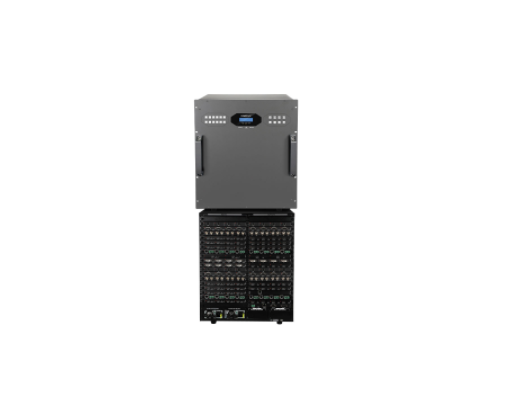What is a video wall processor?
Unveiling the Power of Video Wall Processors: Crafting Seamless Visual Experiences
In the dynamic world of technology, where visual displays play an increasingly pivotal role in communication, the concept of a video wall has risen to prominence. A stunning amalgamation of creativity and innovation, video walls are designed to captivate audiences and deliver impactful messages on a grand scale. At the heart of these impressive installations lies a crucial component known as the video wall processor – a behind-the-scenes marvel that orchestrates the magic of seamless and synchronized visual displays.
Defining the Video Wall Processor
A video wall processor is a specialized device that serves as the central control unit for managing multiple displays to create a unified and synchronized visual canvas. It is the technological bridge that transforms individual screens into a cohesive and immersive experience, presenting content with precision and fluidity. By integrating multiple sources of input, such as video feeds, images, and data, a video wall processor enables the composition of captivating and dynamic visual narratives.
The Anatomy of a Video Wall Processor
A video wall processor is a complex piece of technology that combines hardware and software elements to deliver its functionalities. The processor hardware typically includes high-performance graphics processing units (GPUs), processors, memory, and input/output interfaces. The software component encompasses user-friendly interfaces and control systems that allow operators to manipulate and customize the display content according to their needs.
Key Features and Capabilities
Display Management and Layout Configuration: One of the fundamental functions of a video wall processor is its ability to manage and arrange the content across multiple displays. This involves defining layouts, such as a single large canvas or a grid of smaller screens, and positioning content precisely within those layouts.
Source Integration: Video wall processors can handle a variety of input sources, including live video feeds, prerecorded content, real-time data visualizations, and more. These sources can be seamlessly integrated and displayed in harmony, enabling diverse content types to coexist on the same screen.
Real-time Visualization: Video wall processors are designed to handle real-time content, making them suitable for applications that require live updates and interactions. This capability is essential for mission-critical operations, control rooms, live events, and broadcast environments.
Content Synchronization: Achieving smooth and synchronized content transitions across multiple displays is a challenging task. Video wall processors excel in ensuring that visual elements flow seamlessly from one screen to another, maintaining a cohesive narrative.
Scaling and Resolution Management: Video wall processors can adapt and optimize content for different screen sizes and resolutions. This flexibility ensures that the visuals are displayed with clarity and precision, regardless of the display configuration.
Comparing Hexacyclic Stone Prices: Worth the Splurge?
The Ultimate Guide to Fiberglass Filter Bags
Which Aluminum Space Frame offers the best value for money?
How galvanized steel coils are made
What is ASTM A105 flange?
What is galvanized iron wire generally used for?
Molten Metal Filtration: Essential Techniques to Ensure Purity & Efficiency
Interactive Touch Control: In some applications, such as interactive exhibits or command centers, video wall processors can support touch interactions. This enables users to engage with the content directly, enhancing engagement and user experiences.
Applications and Industry Use Cases
The versatility of video wall processors lends itself to a wide range of applications across various industries:
Command and Control Centers: Video wall processors are instrumental in control room environments, where operators need to monitor multiple data sources, security feeds, and other critical information simultaneously. The processors enable real-time visualization of complex data, enhancing situational awareness and decision-making.
Digital Signage and Retail: In retail settings, video walls can be used to create visually captivating displays that showcase products, promotions, and branding. Video wall processors help in designing attention-grabbing layouts and managing content updates.
Entertainment and Events: Concerts, conferences, and sporting events leverage video wall processors to deliver immersive visual experiences to large audiences. The processors enable live feeds, dynamic graphics, and engaging visual effects to enhance the event atmosphere.
Broadcast and Media: Newsrooms and broadcasting studios use video wall processors to present breaking news, graphics, and data in a visually compelling manner. The processors facilitate real-time updates and seamless transitions between different content elements.
Education and Museums: Video walls in educational settings and museums provide interactive learning experiences. Video wall processors play a crucial role in orchestrating educational content, animations, and multimedia presentations.
The Future of Video Wall Processors
As technology continues to evolve, video wall processors are likely to see advancements that further enhance their capabilities and user experiences. One trend is the integration of artificial intelligence (AI) and machine learning algorithms, which can enable real-time content optimization, automatic layout adjustments, and intelligent content recommendations based on user interactions.
Moreover, advancements in display technologies, such as finer pixel pitches, improved color accuracy, and higher resolutions, will drive the demand for more powerful video wall processors capable of handling these complex visual requirements.
Conclusion
In an era where visual communication holds unparalleled significance, video wall processors emerge as the unsung heroes behind awe-inspiring displays. Their ability to seamlessly combine diverse content sources, orchestrate captivating layouts, and deliver immersive experiences sets the stage for an array of applications across industries. From command centers that require vigilant monitoring to retail spaces that aim to enthrall customers, video wall processors enable the creation of visual narratives that leave a lasting impact. As technology marches forward, these processors will continue to evolve, ensuring that the art of storytelling through visuals remains at the forefront of our digital experiences.
Molten Metal Filtration: Revolutionizing Industrial Production?
Which aluminum screens for doors offer the best value and durability?
Which Industries Can Benefit from 1 Kg Graphite Crucibles?
The Future of Nichrome Wire: Revolutionizing Energy Storage?
The Future of Petroleum Coke: Eco-Friendly Applications & Sustainable Alternatives
What magnet is stronger than neodymium?
The Ultimate Guide to Crimped Stainless Steel Mesh
335
0
0
Related Articles
-
Which Metal Element Additive Price Stackup: Worth the Investment?
Do you ever wonder if using metal element additive price stackup is worth the investment?
222
0
0
-
229
0
0
-
96
0
0
-
Fiberglass Innovation: Revolutionizing Industries with Advanced Tech
Google Hot Topics: "Fiberglass Innovation: Revolutionizing Industries with Advanced Tech?
89
0
0
-
Is Investing in Al-Mg-Mn Panel Roof and Wall Worth It? Tips to Make the Right Decision!
When it comes to constructing or renovating our homes, choosing the best materials is essential.
250
0
0
-
104
0
0
-
110
0
0
-
Which is the best online retailer to purchase affordable loaf neodymium magnets?
Which is the best online retailer to purchase affordable loaf neodymium magnets?
88
0
0










Comments
All Comments (0)